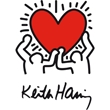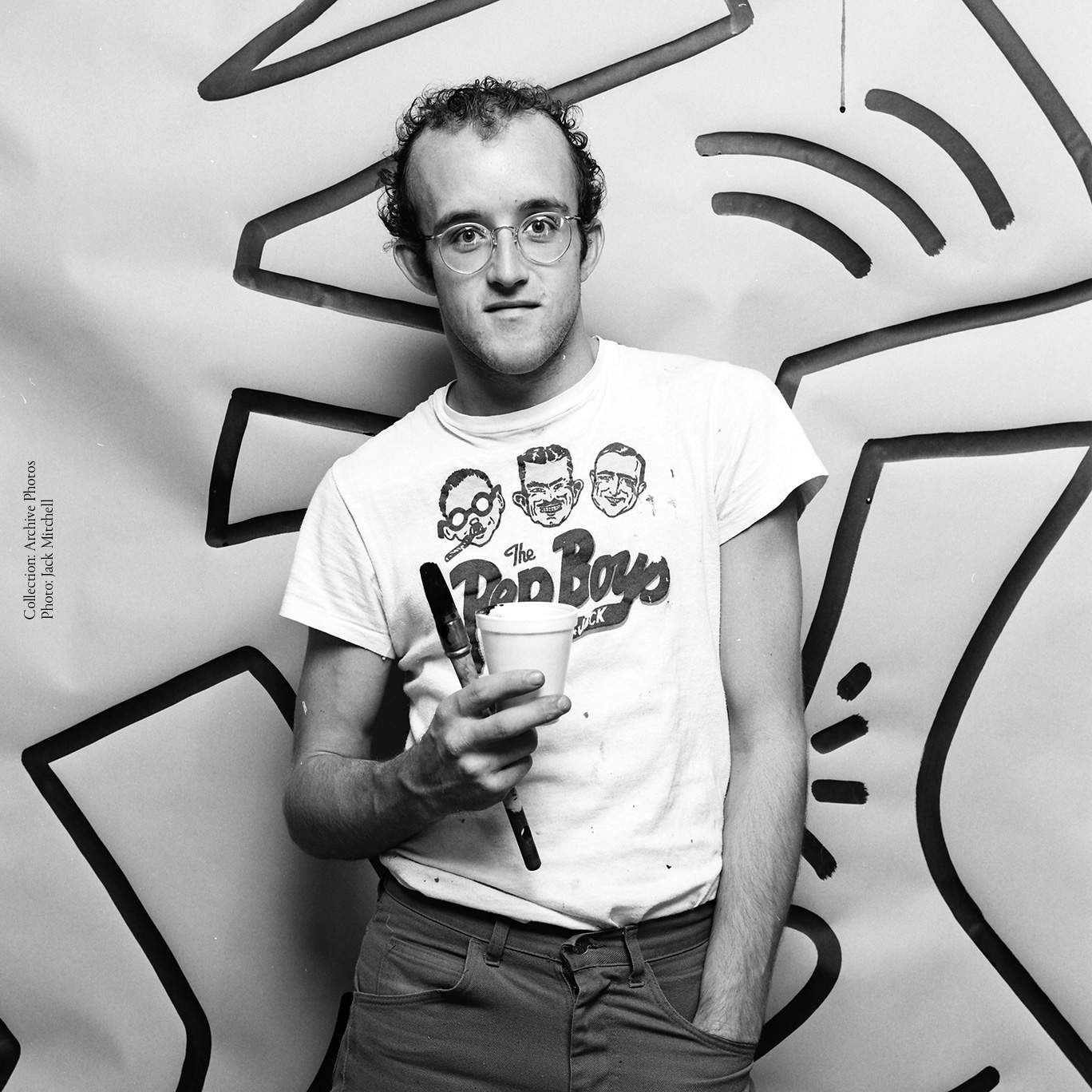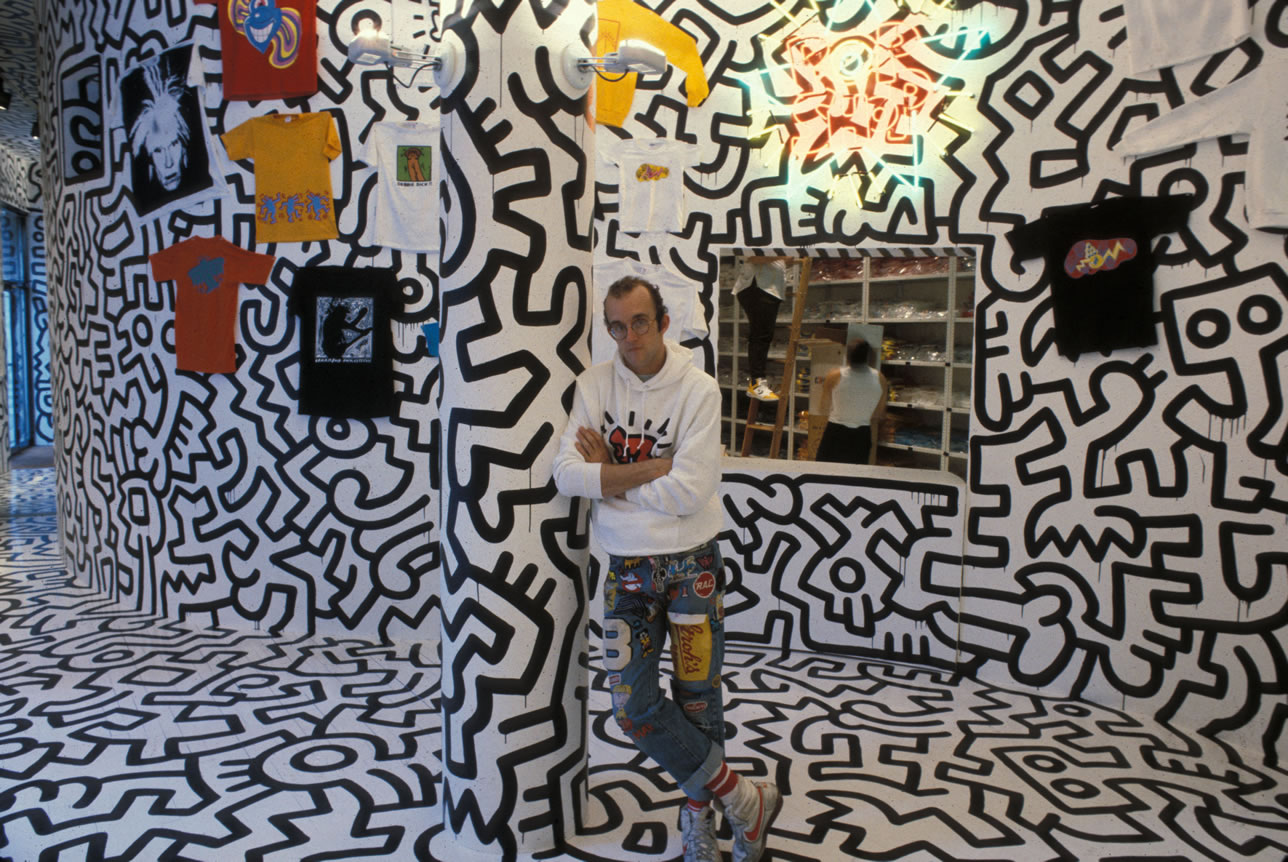Kith Haring Artworks
-
![Keith Haring artwork Radiant Baby,Keith Haring art]()
Keith Haring artwork Radiant Baby
"Radiant Baby" is one of Keith Haring's most recognizable and iconic artworks. The piece typically features a simple yet powerful image of a baby with a radiant aura or energy emanating from it.
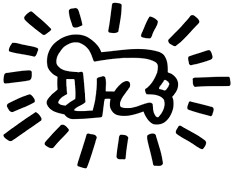
The "Radiant Baby" became synonymous with Haring's style, which was characterized by bold lines, bright colors, and a pop art sensibility. It represents innocence, new life, and the potential for positive change.
The baby in the artwork is often depicted with a simple outline, filled with vibrant colors or patterns. The use of radiant lines or beams coming from the baby adds a sense of energy and dynamic movement. Haring intended for his art to have a universal and accessible appeal, and the "Radiant Baby" is a prime example of this.
The "Radiant Baby" has become an emblem of Haring's art and his message of love, unity, and acceptance. It has been reproduced on various mediums, including posters, t-shirts, and other merchandise, making it widely recognizable and beloved.
Do you have a personal connection or interpretation of the "Radiant Baby"? How does this artwork make you feel?
-
![Keith Haring workarts Montreux 1983]()
Keith Haring workarts Montreux 1983
Created in 1983, Monteux is hand-signed by Keith Haring (Reading, 1958 – New York, 1990) in pencil in the bottom right margin and numbered from the edition of 80.
Catalogue Raisonné & COA:
Keith Haring Monteux, 1983 is fully documented and referenced in the below catalog raisonnés and texts (copies will be enclosed as added documentation with the invoices accompanying the work's sale).1. Littmann, Klaus. Keith Haring: Editions on Paper 1982-1990 (The Complete Printed Works). Germany: Hatje Cantz Publishers, 1993. Listed and illustrated on pages. 24 and 25.
2. A Certificate of Authenticity will accompany this artwork.About the Framing:
Framed to museum-grade, conservation standards, Keith Haring Montreux, 1983 is presented in a complementary molding and finished with silk-wrapped mats and optical-grade Plexiglas. -
![Keith Haring's artwork Anti-Nuclear Rally]()
Keith Haring's artwork Anti-Nuclear Rally
Keith Haring was an artist and social activist who was passionate about a variety of issues, including anti-nuclear activism. Haring believed in using his art as a means of communication and raising awareness about important social and political matters.

Haring's thoughts on anti-nuclear likely stemmed from his concern for the environment and the potential dangers of nuclear technology. He may have been motivated by a desire to protect the planet and its inhabitants from the negative effects of nuclear weapons, nuclear power plants, or other nuclear-related activities.
Through his artwork, Haring potentially sought to convey messages about the risks of nuclear proliferation, the need for alternative sources of energy, and the importance of peace and disarmament. His art could have served as a visual commentary on the nuclear issue, using his characteristic bold and graphic style to draw attention to the subject.
It's important to note that while we can make assumptions about Haring's thoughts based on his art and known activism, we can't know his exact views and motivations with certainty. Art is subjective, and artists often express complex ideas and emotions through their work.
If you're interested in learning more about Haring's thoughts on anti-nuclear or other topics, I recommend exploring his art, reading interviews or articles about him, or researching his broader body of work and the social and political context in which he operated. This can provide a deeper understanding of his perspective and the messages he aimed to convey through his art.
-
![Keith Haring artwork Keith Haring Growing (Plate 1),Keith haring art]()
Keith Haring artwork Keith Haring Growing (Plate 1)
Keith Haring Growing (Plate 1), 1988 is the first installment of the artist’s Growing portfolio of 1988. In this work, Haring illustrates a flat yellow background and a blue ground embellished with short black lines. Atop the center of this backdrop, the artist renders a large red figure outlined in black. This figure appears to be comprised of three individuals disassembled and rearranged to create one towering form with six arms, six legs, and one head. This figure stretches nearly the entire length of the composition and mimics the visual language of hieroglyphics. This language is similar to the language of advertising, and in making this work Haring uses his screenprinted figures to communicate his ideals in a manner that appeals to mass media.

Keith Haring’s Growing (Plate 1), 1988 is part of a portfolio of five screenprints in the artist’s Lucky Strike portfolio of 1987. This body of work depicts fragments of figures rendered in the artist’s signature style dismantled and reconstructed to create enormous singular forms that dominate their compositions. Also featured in this portfolio are Growing (Plate 2), Growing (Plate 3), Growing (Plate 4), and Growing (Plate 5).
Created in 1987, this silkscreen is hand-signed by Keith Haring (Reading, 1958 – New York, 1990) in pencil in the center right image and numbered from the edition of 80 in pencil in the center right image.
-
![Keith Haring artwoke Pop Shop 1]()
Keith Haring artwoke Pop Shop 1
Keith Haring Pop Shop I, 1987 is a suite of four silkscreen prints, each of which comes from an edition of 200. This suite is the first of six Pop Shop suites that Haring created in his lifetime. This one features images using the same five colors: turquoise, red, yellow, purple, and black.

-
![Keith Haring artwork safe sex 1988,Keith Haring art]()
Keith Haring artwork safe sex 1988
Keith Haring's artwork related to safe sex often incorporated his signature style of bold lines, simple shapes, and vibrant colors. He used these visual elements to convey messages about sexuality, AIDS prevention, and the importance of safe sexual practices.

Haring's safe sex artwork aimed to raise awareness and challenge societal taboos surrounding sexuality. He believed in using art as a tool for education and empowerment, particularly in the context of the AIDS epidemic during his time.
His artworks might feature symbols such as condoms, hearts, or other graphic representations to visually communicate the message of safe sex. He might have also incorporated text or slogans to reinforce the importance of protecting oneself and others. By using a visual language that was accessible and easily recognizable, Haring hoped to reach a wide audience and start conversations about sexuality and sexual health.
His artwork could serve as a reminder to take responsibility for one's actions and to prioritize the well-being of both individuals and the community.
Haring's safe sex artwork was part of his broader social and political commentary, as he was passionate about using his art to address important issues and effect positive change. His art continues to be relevant today, as it prompts reflection on sexuality, health, and the power of visual communication.
Keith Harring Quotes Read More »
-
![Keith Karing quotes art is for everybody]()
Art is for everybody
-
![Keith Haring quotes Everybody draws when they are little.]()
Everybody draws when they are little.
-
![Keith Haring quotes Art is nothing if you don't reach every segment of the people.]()
Keith Haring quotes Art is nothing if you don't reach every segment of the people.
-
![Keith Haring quotes Nothing is important, so everything is important.]()
Nothing is important, so everything is important.
-
![Keith Haring quotes Art should be something that liberates your soul.]()
Art should be something that liberates your soul.
-
![Keith Haring's quotes The best reason to paint is that there is no reason to paint.]()
The best reason to paint is that there is no reason to paint.
-
![]()
Keith Haring's quots Whatever you want to do, the only secrect is to believe in it.
-
![Keith Haring quotes When it is working, you completely go into another place, you're tapping into things that totally universal,completely beyond your ego.]()
When it is working, you completely go into another place, you're tapping into things that totally universal,completely beyond your ego.
Keith Harring Clothing Read More »
About Keith Haring
-
![The Legendary Life of Keith Haring, Keith Haring's birth, Keith Haring's death]()
Keith Haring biography
Keith Haring's birth
Keith Haring was born in Reading, Pennsylvania on May 4, 1958, and grew up in nearby Kutztown. He developed a love for drawing at a young age and learned basic comic book techniques from his father and the popular culture around him, such as Dr. Seuss and Walt Disney.
Keith Haring's school career
After graduating from high school in 1976, Haring attended the Ivy Professional School of Art in Pittsburgh, a commercial art school. He quickly realized that he was not interested in becoming a commercial graphic artist and dropped out after two semesters. In Pittsburgh, Haring continued to study and create his work and held his first solo exhibition at the Pittsburgh Arts and Crafts Center in 1978.
Later that year, Haring moved to New York City and attended the School of Visual Arts (SVA). In New York, Haring discovered a thriving alternative arts community that was developing in downtown streets, subway stations, and clubs and former dance halls outside of the gallery and museum system. Here, he became friends with artists Kenny Scharf and Jean-Michel Basquiat, as well as other musicians, performance artists, and graffiti artists who were part of the emerging art scene. Haring was swept up in the energy and spirit of this scene and began organizing and participating in exhibitions and performances at 57 Club and other alternative venues.
In addition to being influenced by the innovation and vitality of his contemporaries, Haring was also inspired by the work of Jean Dubuffet, Pierre Alechinsky, William Burroughs, Brion Gysin, and Robert Henri's "The Spirit of Art," which asserted the essential independence of the artist. Under these influences, Haring could channel his youthful impulses into a unique graphic expression based on the primacy of the line. He was also drawn to the public and participatory nature of Christo's work, particularly "The Running Fence," and the way Andy Warhol blended art and life in his work. Haring was determined to dedicate his career to creating true public art.
As a student at SVA, Haring experimented with performance, video, installation, and collage while remaining steadfastly committed to painting. In 1980, Haring discovered a highly effective medium in the subway that allowed him to communicate with a wider audience than he desired. He noticed an unused advertisement panel covered with matte black paper and began creating drawings with white chalk on these blank panels throughout the subway system. Between 1980 and 1985, Haring created hundreds of these public paintings, sometimes creating as many as 40 "subway paintings" in a single day. The seamless flow of these images became familiar to New York commuters, and they often stopped to engage with the artist when they encountered him at work. The subway became Haring's so-called "laboratory" where he could work out his ideas and experiment with his simple line.
Keith Haring's art career
Between 1980 and 1989, Haring gained international recognition and participated in numerous group and solo exhibitions. His first solo exhibition in New York was held at the Westbeth Painters Space in 1981. In 1982, he held a highly popular and critically acclaimed solo exhibition at the Tony Shafrazi Gallery, making his debut at a SoHo gallery. During this period, he also participated in renowned international survey exhibitions such as the 7th Documenta in Kassel; the Biennale de São Paulo; and the Whitney Biennial. Haring also completed numerous public projects during the 1980s, ranging from animations for Spectacolor billboards in Times Square, set and backdrop designs for theater and clubs, designing watches for Swatch, and creating an advertising campaign for Absolut Vodka; to creating murals around the world.
In 1986, Haring opened The Pop Shop, a retail store in SoHo that sold T-shirts, toys, posters, buttons, and magnets featuring his images. Haring saw the store as an extension of his work, and he painted an abstract, black-and-white mural throughout the interior of the store, creating a striking and unique retail environment. The store was intended to make his work more accessible to the public, which could now be obtained at a lower cost on products. The store was met with criticism from some in the art world, however, Haring remained committed to his desire to reach as wide an audience as possible with his work and was supported by friends, fans, and mentors, including Andy Warhol.
Throughout his career, Haring dedicated much of his time to creating public works that often conveyed social messages. He created over 50 public artworks between 1982 and 1989 in dozens of cities around the world, many of which were created for charities, hospitals, daycare centers, and orphanages. The now-famous Crack is Wack mural became a landmark along FDR Drive in New York in 1986. Other projects included; a mural created for the 100th anniversary of the Statue of Liberty in 1986, which Haring collaborated on with 900 children; a mural outside the Necker Children's Hospital in Paris, France in 1987; and a mural painted three years before the fall of the Berlin Wall. Haring also conducted painting workshops for children in schools and museums and created images for numerous literacy programs and other public service activities.
In 1988, Haring was diagnosed with AIDS. In 1989, he established the Keith Haring Foundation, whose mission was to provide funding and imagery for AIDS organizations and children's programs and to expand the reach of Haring's work through exhibitions, publications, and the licensing of his images. In the final years of his life, Haring used his images to speak about his illness and inspire action and awareness around AIDS.
Haring's work was featured in over 100 solo and group exhibitions in the 1980s during his brief and intense career. In 1986 alone, he was the subject of over 40 newspaper and magazine articles. He was highly sought after, participating in various collaborative projects and collaborating with artists and performers such as Madonna, Grace Jones, Bill T. Jones, William Burroughs, Timothy Leary, Jenny Holzer, Yoko Ono, and Andy Warhol.
By expressing universal concepts such as birth, death, love, sex, and war through the primacy of line and the directness of his messaging, Haring was able to engage a broad audience and ensure the accessibility and lasting impact of his images, which have become recognized as a visual language of the 20th century.
Keith Haring's death
On February 16, 1990, Haring passed away due to AIDS-related complications at the age of 31. A memorial service for him was held at St. John the Divine Cathedral in New York with over 1,000 people in attendance.
Since his death, Haring has been the subject of several international retrospective exhibitions. The works of Keith Haring can be seen in exhibitions and collections at major museums around the world.
-
![Keith Haring Self Portrait]()
Keith Haring's self portrait
Keith Haring's Self Portrait is a famous painting by the American artist Keith Haring. This painting is one of Haring's most recognizable works and features his unique style of graffiti-like lines and symbols.
In the Self Portrait, Haring depicts himself with a simplified, cartoon-like style. He uses bold lines and bright colors to create a dynamic and lively image of himself. Haring's use of symbols in the painting, such as the heart and the arrow, adds to the overall impact of the piece and conveys a sense of energy and movement.
The Self Portrait is not only a representation of Haring's appearance but also a reflection of his personality and artistic style. Through this painting, Haring expresses his creativity, playfulness, and love for art. It has become an iconic image of the artist and is widely recognized and admired by art lovers around the world.
Keith Haring's Self Portrait
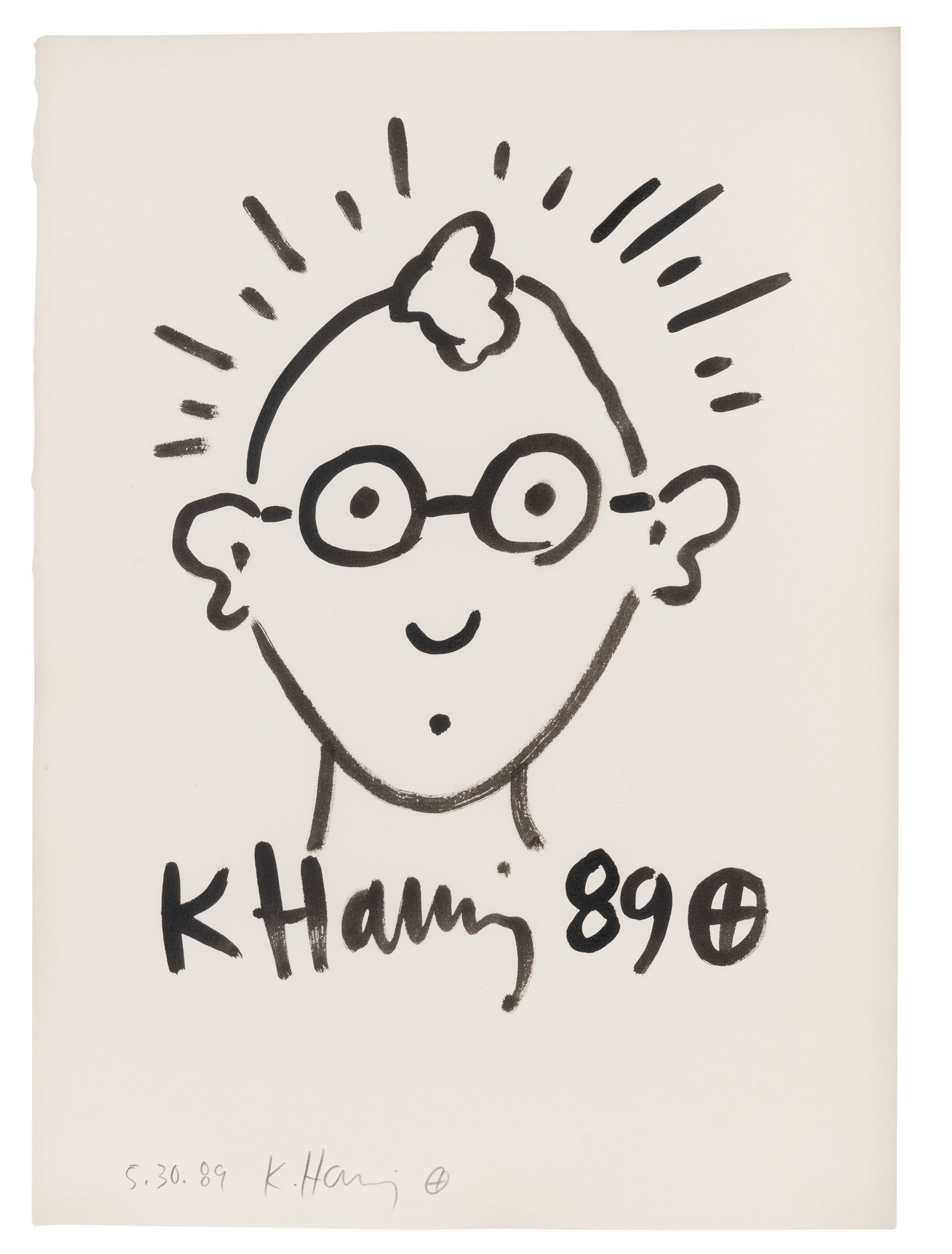
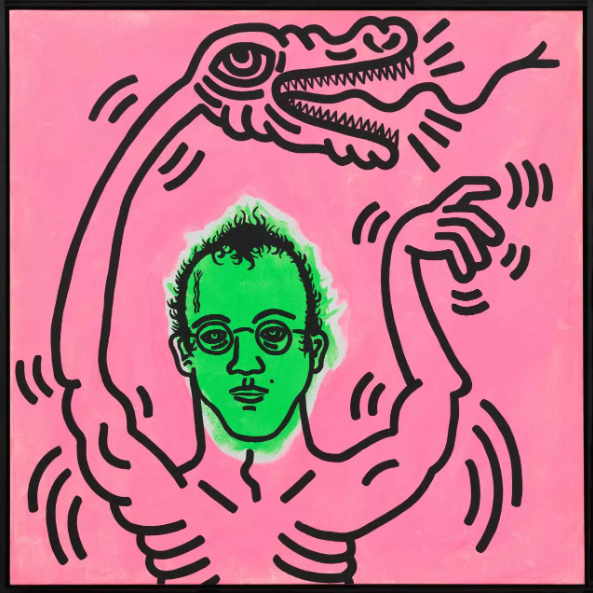

Keith Haring's Portrait By Others

Keith Haring Painting by Kascho
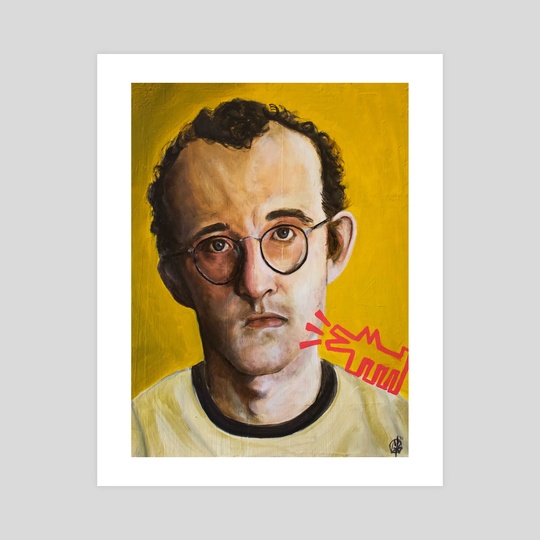
Keith Haring painting by Gabriel Paul Bustos
-
![The Keith Haring Pop Shop, pop shop keith haring]()
The Keith Haring Pop Shop
